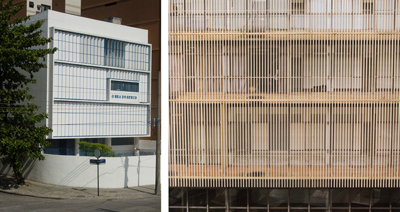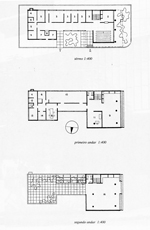You are in: Home page > Magazine > The interaction between the building and the city

Carlo Gandolfi
The interaction between the building and the city
Abstract
For Niemeyer architecture is a whole with the city and the territory. The ways through which he separates the building from the open space and from the city are a crucial issue to analyse this relationship. We find ourselves in front of a research that superates by far the simple evolution of Le Corbusier and the simple sculptural ability that was attributed to it: the one by Niemeyer is a wide breath composition, with an ongoing evolution and tension with the city and the landscape.
Recent Brazilian architecture today represents, also as regards to the tradition of the modern and its following declinations, one of the most rich and useful experiences to understand how the continuous tension between building and city can influence the urban quality establishing its character. With regard to the issue of the relationship between building and open space within the contemporary metropolis, it works for the most of the time - think for example, to quote but a few, to João Vilanova Artigas, Paulo Mendes da Rocha, Lina Bo Bardi – in contexts that are recent or far from the concept of “historic city”.
The parallel look at architecture itself - on the single building and on the parts that articulate it - and at the relationship that this establishes with the urban space is one of the figures of Brazilian architecture and in this specific case that of the carioca architecture.
The first work he realised independently has been the Obra do Berço, in 1937, a small building assigned to social serviced in Rio de Janeiro. It is with this building that started the use of vertical screening blades on the facade, a sort of evolution of the Brazilian Muxarabis inherited by the Arab tradition, sort of wooden “fabrics” used to screen the internal spaces from the strong rays of sunshine. “The brise soleil is a solution offered by Le Corbusier as a thermic protection in Algeria. [...] Along time it would be used also by us”: in a very specific essay on this issue (1), Niemeyer illustrates its use and merits/qualities.
If the facade is the “hierarchically relevant element of the project” to which is “given the task of the relationship with the city” (2), we could then identify in this explicit quote by Le Corbusier referred to a specific architectural element a useful base for later considerations. Niemeyer often goes back to the issue of the facade intended as an urban device and as a diaphragm able to put into relation “and harmony” the inside on the outside of the building. He does the same thing in another essay: “One of the biggest problems of current architecture is the one of urban unity. This is the harmony among buildings, volumes, height and free spaces that constitutes the architecture of the city” (3). In the same article Niemeyer concisely explains the way in which, in the case of Brasilia, the problem is not specifically linked to the language of the single building but to a higher order, on an urban scale, able to give to “parts” of the city a specific recognisability. The fact that, according to Niemeyer, the relationships between parts come before the language of the single parts helps us making lear the misunderstanding that has accompanied its work for decades, that is to be read first of all as a set of free shapes, quotes of the organic shapes of the earth and of the woman.
Niemeyer’s architecture is also this, but not only: the power of its work - and its very topicality - lies in the planimetric composition, in the relationship that the single architecture establishes with the city and not only within immediate terms.
The continuous hymn to curves carried out almost systematically inside its work must not be interpreted as a spasmodic and obsessive formal imperative but on one side as the continuous and careful investigation of the shape itself as regards to contemporary technology (4) and on the other as a series of visual relationships. Immediate and distant: the eye and the man that measures space are omnipresent in his sketches.
Experimentation, in this sense, found its peak in the 50s and 60s, with works as Edificio Copan a San Paolo del 1951-3 o l’edificio Niemeyer di Belo Horizonte del 1954, in which Niemeyer investigated, in the same way of giant urban objects, the issue of the building with mixed or residential use within the urban fabric, coceiving it as a complex organism. In the case of Copan, the winding shape collaborates with the hardening of the structure. It cancels, in facts, the architectural solution alla ricerca di una potente unitarietà della massa alla stregua di un importante caposaldo urbano. The building then assumes an urban condition of great disorder, made of additions and discontinuity, aiming - only through a compact and recognisable sign - at getting over the traditional block type.
Niemeyer collaborated with Le Corbusier (and Lúcio Costa, Affonso Reidy, Ernani Vasconcelos and others) to the Ministery of Education and Health of Rio de Janeiro from 1936. This building represents the first example of application on a big scale of corbusierian principles: “the detached pilotis on which the building stands, the independent structures, the planimetric freedom, the “pan de verre” used as an ideal limit of the internal space, the isolation of the building’s volume in the contest of the urban environment, the characteristics of continuity at the level of the ground [...]” (5). The elements of the corbusieran lesson are interiorised by Niemeyer in a sort of powerful asbstraction: the research is that of a new or future architecture: we can speak about a passing that takes place through an ongoing experimentation. That of Niemeyer is an architecture of the distance, of the territory, of the city intended as a vast entity. Its lesson is the attention for the human being and at the same time for the faith in architecture intended not as a heal-all remedy to the evil in society, but as a possibility for the future, as the collective art par excellance.
Captions
(1) Niemeyer, O. (1939). A proteção da fachada oeste por “brise soleil”. Revista Municipal de Engenharia: Rio de Janeiro, v. 6, n° 3, maggio 1939, p. 282-3. T.d.A.
(2) Pierini, O. S. (2008) Sulla facciata. Tra architettura e città. Maggioli: Santarcangelo di Romagna, p. 9.
(3) Niemeyer, O. (1993). A Unidade Urbana. In Conversa de arquiteto. Revan: Rio de Janeiro, p. 40. T.d.A.
(4) “Un’architettura non deve solamente essere bella, ma deve testimoniare le possibilità tecniche del suo tempo”. Aforisma. S. d.
(5) Bullrich, F. (1970). Orientamenti nuovi nell’architettura dell’America Latina. Electa: Milano, p. 18.
















